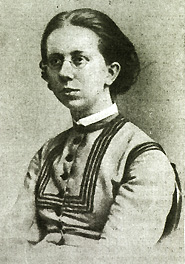Julia Lermontova facts for kids
Quick facts for kids
Julia Lermontova
|
|
|---|---|
 |
|
| Born |
Julia Lermontova
21 December 1846 |
| Died | 16 December 1919 (aged 72) |
| Nationality | Russian |
| Alma mater | University of Göttingen |
| Known for | First Russian female doctorate in chemistry |
| Scientific career | |
| Fields | Chemistry |
Julia Lermontova (born December 21, 1846 – died December 16, 1919) was an important Russian chemist. She is famous for being the first Russian woman to earn a doctorate degree in chemistry. She studied at the University of Heidelberg and the University of Berlin before getting her doctorate from the University of Göttingen in 1874. In 1875, she became a member of the Russian Chemical Society.
Contents
Early Life of Julia Lermontova
Julia Vsevolodovna Lermontova was born on December 21, 1846, in St. Petersburg, Russia. Her parents were Elisawjeta Andrejevna Kossikovsky and General Vsevolod Lermontov. Her father was a distant cousin of the famous Russian poet Mikhail Lermontov.
Julia spent most of her childhood in Moscow. Her father was in charge of the Moscow Cadet Corps. Her parents were well-educated and believed strongly in their children's learning. Because of this, Julia was taught by private tutors at home.
Even though her family didn't fully understand her love for science, they didn't stop her. She often read science books and did simple experiments at home.
Julia Lermontova's Education
Studying in Russia
Julia Lermontova first wanted to study medicine. However, she soon found she couldn't stand the sight of skeletons or the difficult lives of sick people. So, she decided to study chemistry instead.
She applied to Petrovskaia Agricultural College, which had a great chemistry program. Many professors supported her, but her application was turned down. This made her decide to go abroad for her education.
At that time, it was hard for women to study at universities in other countries. Julia met Sofia Kovalevskaia through her cousin, Anna Evreinova. Sofia had entered a "marriage of convenience," which was a special agreement that allowed both women to study abroad. Sofia could act as a chaperone, making it easier for Julia to go.
Studying Abroad
In the fall of 1869, when she was 22, Julia Lermontova went to Heidelberg University in Germany. She was allowed to attend Robert Bunsen's lectures and later joined his laboratory. In Bunsen's lab, she researched platinum compounds. This work helped develop ways to separate platinum alloys. Mendeleev, a famous chemist, suggested this research to her.
After Heidelberg, she moved to Berlin to work with August Wilhelm von Hofmann. She worked in his private lab and attended his lectures on organic chemistry. Here, she published her first scientific paper, "Ueber die Zusammensetzung des Diphenins."
In 1874, she finished her main research paper, called ‘Zur Kenntniss der Methylenverbindungen,’ which was about analyzing methyl compounds. That same fall, she earned her Doctor of Chemistry degree from the University of Göttingen. She graduated with high honors and became the first woman in the world to get a doctorate in chemistry.
Julia Lermontova's Research
After finishing her studies, Julia Lermontova returned to Russia. She started working in Vladimir Markovnikov's lab at the University of Moscow. Later, she was invited by Alexander Butlerov to move to St. Petersburg. There, she researched 2-methyl-2-butenoic acid.
In 1877, after her father passed away, she moved back to Moscow with her family. She continued working in Markovnikov's lab, focusing on oil research. She was the first woman to work in this field. She also invented a device for continuously distilling petroleum, but it couldn't be used on a large industrial scale.
At a meeting of the Russian Chemical Society in January 1878, A. P. Eltekov presented a new way to create hydrocarbons. Butlerov pointed out that Julia had already done many of these experiments. This research later became very important for making highly branched hydrocarbons, which are used in some types of motor fuels. This process is now known as the Butlerov–Eltekov–Lermontova reaction.
Butlerov tried to convince her to teach at special courses for women. However, she didn't accept, worried that the Minister of Education might not allow it. In 1881, she became the first woman to join the Russian Technical Association.
Life After Research
Julia Lermontova inherited her family's estate in Semenkovo. She used to spend her summers there and eventually moved there permanently. After moving to Semenkovo, she stopped her chemistry research.
She became very interested in agricultural sciences. She developed a special kind of cheese that was sold all over Russia and Ukraine. In the spring of 1889, she became very ill with double pneumonia. That fall, she traveled to Stockholm to visit her friend Sofia Kovalevskaya.
In 1890, Kovalevskaya visited St. Petersburg with her daughter, Fufa. Lermontova met them and took care of Fufa before Kovalevskaya's death in 1891.
After the October Revolution in 1917, there was an attempt to take over her estate in Semenkovo. However, with help from the Minister of Education, Anatoli Lunascharski, she was allowed to keep it. Julia Lermontova died in 1919 from a brain hemorrhage. She never married, and Sofia (Fufa) Kovaleyskaya, her step-daughter, inherited her entire estate.
See also
 In Spanish: Julia Lermontova para niños
In Spanish: Julia Lermontova para niños


